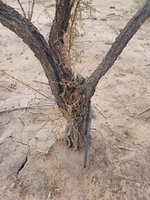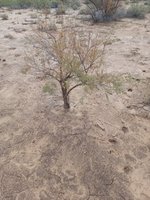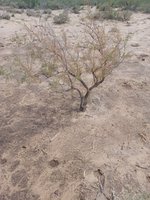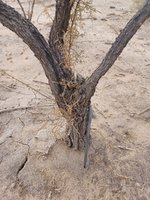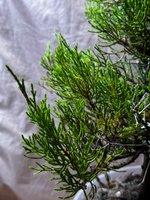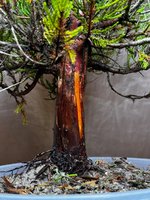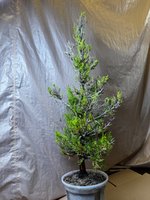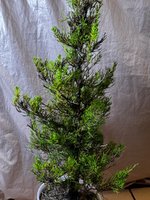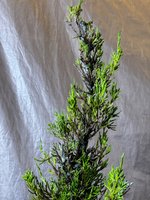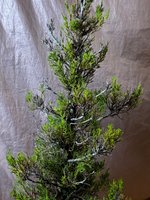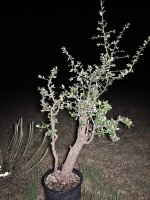Is it okay to do it now?They seem to respond well to heavy wiring. There's quite a bit of foliage there to maybe wire and compress down into a more compact tree. It will probably give you juvenile foliage in spades. I don't really mind it, but some do.
You are using an out of date browser. It may not display this or other websites correctly.
You should upgrade or use an alternative browser.
You should upgrade or use an alternative browser.
The 2024 Yamadori/Collecting Thread
- Thread starter Cajunrider
- Start date
Joe Dupre'
Omono
I don't think it would do any harm, but I feel the best way is to wire in early spring/late winter.Is it okay to do it now?
Orion_metalhead
Masterpiece
Barbells and bonsai
Shohin
Cajunrider
Imperial Masterpiece
Cost for DaPoPoMeet DaPoPo
View attachment 563788
80 miles round trip; 2 hours slopping in da mud; $20 for the tub; $10 for the soil; 2 hours for planting the tree; $200 citation + 1 hr Safe Driving class to get the ticket dismissed; 2 weeks of twice daily watering.
Let’s not forget the laughter from my friends at the reserve.
We got a BUD!
Expecting matriculation from the back porch to the sun in 4 weeks.
Joe Dupre'
Omono
I am truly blessed. My bald cypress trips generally go like this. Drive to collecting spot - 10 minutes. Park and walk 100 feet to pick out 3"-8" trees usually 20-30 feet apart. Dig tree- a BIG one might take 40 minutes. Drive back, pot up the tree with a pile of "dirt" from the yard , clean up -- another hour . Total time - about 2 1/2 hours and $2.00 worth of gas. I envy the yamadori juniper and pine collectors, but I have it pretty good.Cost for DaPoPo
80 miles round trip; 2 hours slopping in da mud; $20 for the tub; $10 for the soil; 2 hours for planting the tree; $200 citation + 1 hr Safe Driving class to get the ticket dismissed; 2 weeks of twice daily watering.
Let’s not forget the laughter from my friends at the reserve.
We got a BUD!
Expecting matriculation from the back porch to the sun in 4 weeks.
ponderingsage
Mame
Yeah, my drive to the Mts is not short which makes for some 10 hour plus days… but it’s always worth it to get out and feed the passion.
BrianBay9
Masterpiece
Mountain collecting often means long drive and no trees collectible. One has to be willing to enjoy the day hiking in the mountains with no results.
ShadyStump
Imperial Masterpiece
I think most people do it backwards, going to the mountains looking for a tree only to just take a long hike.Mountain collecting often means long drive and no trees collectible. One has to be willing to enjoy the day hiking in the mountains with no results.
A truly good day is going to the mountains looking for mountains only to find yourself, and a tree follows you home.
Cajunrider
Imperial Masterpiece
If it were me, I would pack light, travel to the mountain area in the range of the tree type I seek. There I will look for the trees and mark the locations of those I want to collect. I call this the Seek phaseI think most people do it backwards, going to the mountains looking for a tree only to just take a long hike.
A truly good day is going to the mountains looking for mountains only to find yourself, and a tree follows you home.
Then I would take care of proper legal requirement for collecting, pack appropriately and go back for collection. I call this the Collect phase.
If I can only make one trip, they I try to find a guide that already has done the Seek phase and know exactly where to go to collect the tree I want.
I also recognize that once in a while by luck I get to do Seek and Collect in the same trip. In a Seek trip, I happen to find a tree convenient to collect or in a Collect trip, I happen to find another tree worth collecting.
19Mateo83
Masterpiece
This is my mentality. I take walk in the woods and a tree just appears in my back seatI think most people do it backwards, going to the mountains looking for a tree only to just take a long hike.
A truly good day is going to the mountains looking for mountains only to find yourself, and a tree follows you home.
Cajunrider
Imperial Masterpiece
Cmd5235
Chumono
All of the ones with the scar down the side make me want to split the trunk like you did. But I do know that scar won’t last long.Some of the beaver damaged trees are growing while a few appear to be dead.
View attachment 566134View attachment 566135View attachment 566136View attachment 566137
I owe you a post of the tree I got from you as well, it’s wonderful!
Desert O'Piñon
Chumono
I agree with this concept...If I can only make one trip, they I try to find a guide that already has done the Seek phase and know exactly where to go to collect the tree I want.
...to a point. Often, when you go to the NFS office to get a collection permit, the person you get it from is pretty knowledgeable in that specific district of the forest. My experience is that they are often very interested in your project, and willing to suggest roads less traveled and areas that might be better hunting. So, I would consider this to be the next best thing to an actual guide, with the added bonus of being free with the purchase of the collection permit.
Desert O'Piñon
Chumono
So I've had my eye on this tamarisk on the yard at work for two or three years now. It's a noxious invasive that the BLM is constantly battling, but this one has a thick trunk with mature bark and gentle movement. Is this going to be worth my trouble?
Attachments
NJtsr95
Seedling
I’ve NEVER seen a Juniperus virginiana with this nearly chartreuse color and adult scale foliage at this density at such a short height. Trunk roughly 1.75” at base. Tons of natural Jin (and it had a jin apex around 2” above the tip but i snapped it off taking it out of my back seat, still mad at myself for that). Only 30” tall but so dense and well proportioned. Im thinking formal upright styled like giant redwood? Trunk fairly straight low down but some nice sinuosity up top, wont even bother trying to wire that but do plan on wiring the branches. Idk where to begin tho.
Its like a beautiful formal upright and I really am curious to experiment with trying to propagate whatever i end up trimming off to see if its genetically different or only because of the conditions it was grown in? Decided to keep around 8” below soil line of the taproot because of the laterals remaining and i unfortunately damaged some of the larger surface laterals. But preserved most of the fine feeder roots right at the base of the root flare. Id like to think i can get rid of more of the taproot but rather safe than sorry.
inside for photographic purposes ONLY!
I’m also undecided about whether or not to remove some of the lichen on the jins or higher up the main stem. I sort of want to expose some red wood on the trunk but I am really struggling to make a committed decision on what to do with this beautiful tree. I do have to go in there before wiring and remove years of needles and dead scales trapped in the crotches of the branches because the branchlet density and angle is high and unusual compared to most of the ones ive seen roughly this size. Which is usually an uninspiring pencil with a lot of prickly semi mature scale-needle combinations.

Its like a beautiful formal upright and I really am curious to experiment with trying to propagate whatever i end up trimming off to see if its genetically different or only because of the conditions it was grown in? Decided to keep around 8” below soil line of the taproot because of the laterals remaining and i unfortunately damaged some of the larger surface laterals. But preserved most of the fine feeder roots right at the base of the root flare. Id like to think i can get rid of more of the taproot but rather safe than sorry.
inside for photographic purposes ONLY!
I’m also undecided about whether or not to remove some of the lichen on the jins or higher up the main stem. I sort of want to expose some red wood on the trunk but I am really struggling to make a committed decision on what to do with this beautiful tree. I do have to go in there before wiring and remove years of needles and dead scales trapped in the crotches of the branches because the branchlet density and angle is high and unusual compared to most of the ones ive seen roughly this size. Which is usually an uninspiring pencil with a lot of prickly semi mature scale-needle combinations.

Attachments
ShadyStump
Imperial Masterpiece
We have the same problems with them here.So I've had my eye on this tamarisk on the yard at work for two or three years now. It's a noxious invasive that the BLM is constantly battling, but this one has a thick trunk with mature bark and gentle movement. Is this going to be worth my trouble?
I haven't seen any examples first hand, but I've read of them doing very well as bonsai. They like alkaline soil, which makes water and substrate easy, and are obviously difficult to kill or they wouldn't be so invasive.
I imagine the best time to dig is about now, or spring as buds swell; similar to most deciduous. That's just a guess, though.
The Barber
Chumono
Just be aware, wiring hardened off branches is rather tough as they become quite brittle, one of the biggest reasons it isn't often used for bonsai. Looks like a nice tree though, if that is a freshly collected tree, I wouldn't work on it till it is showing vigorous growth.I’ve NEVER seen a Juniperus virginiana with this nearly chartreuse color and adult scale foliage at this density at such a short height. Trunk roughly 1.75” at base. Tons of natural Jin (and it had a jin apex around 2” above the tip but i snapped it off taking it out of my back seat, still mad at myself for that). Only 30” tall but so dense and well proportioned. Im thinking formal upright styled like giant redwood? Trunk fairly straight low down but some nice sinuosity up top, wont even bother trying to wire that but do plan on wiring the branches. Idk where to begin tho.
Its like a beautiful formal upright and I really am curious to experiment with trying to propagate whatever i end up trimming off to see if its genetically different or only because of the conditions it was grown in? Decided to keep around 8” below soil line of the taproot because of the laterals remaining and i unfortunately damaged some of the larger surface laterals. But preserved most of the fine feeder roots right at the base of the root flare. Id like to think i can get rid of more of the taproot but rather safe than sorry.
inside for photographic purposes ONLY!
I’m also undecided about whether or not to remove some of the lichen on the jins or higher up the main stem. I sort of want to expose some red wood on the trunk but I am really struggling to make a committed decision on what to do with this beautiful tree. I do have to go in there before wiring and remove years of needles and dead scales trapped in the crotches of the branches because the branchlet density and angle is high and unusual compared to most of the ones ive seen roughly this size. Which is usually an uninspiring pencil with a lot of prickly semi mature scale-needle combinations.
View attachment 566443
NJtsr95
Seedling
Yes thats the main reason I’m not even bothering trying to touch the trunk and as stated i unfortunately snapped off the jin apex. Just to be clear my plan was to only ever so lightly wire some of the live branches down ever so slightly which i experimented with gently teasing down some of the branches about 1/2-1” just to open up a little bit of space between the natural “pads” that already formed. And im quite happy with the natural movement and swooping of some of the lower down branches.Just be aware, wiring hardened off branches is rather tough as they become quite brittle, one of the biggest reasons it isn't often used for bonsai. Looks like a nice tree though, if that is a freshly collected tree, I wouldn't work on it till it is showing vigorous growth.
I’m not sure this light of wiring some branches down ever so slightly (but not changing the overall shape of the branches) would stress the tree at all?
As stated i do want to choose a few branches to remove (like maybe two medium branches in the middle and some of the crotch growth i will painstakingly attempt to harvest into heel cuttings.
But mainly because i don’t really want to deal with the million branchlets and some of the spiky dead interior foliage, I may take your advice and hold off on wiring it. But I could use some guidance choosing a front and deciding what to remove. Ive got two angles on opposite sides im split on.
Until then tho im going in there with tweezers to gently tease out some of the debris and needles and pine needles stuck in the crotches.
To be clear tho i thought ERC made bad bonsai because of the typical growth form, and mediocre foliage when spiky. With my “in the wild” experience of walking on branches that were too thin in various habitats, apart from pines i find most conifers, like Chaemycyparis (A white Cedar), most Junipers and Thuja/Tsuga to have similar characteristics of having a bit of flexibility and being relatively rot resistant but when it snaps it tends to shatter quite abruptly ( I ended up in the muck of White cedar swamps a few times from the logs snapping like this). So im not sure if J vir is generally “special” in that respect but I have heard junipers growing in arid regions like the west US species/San jose var chinensis being especially brittle.
But because this is a special specimen that I genuinely dont want to ruin, ill hold off on wiring, now just to choose what to remove. I figure most of the tiny dead twigs (perhaps near the apex) and dead crotch growth are fairly safe to remove. Thanks for the reply though!
Big Country Bonsai
Shohin
Similar threads
- Replies
- 1
- Views
- 593
- Replies
- 0
- Views
- 90







